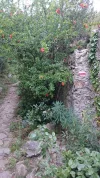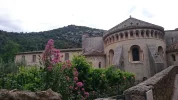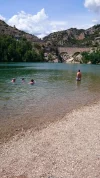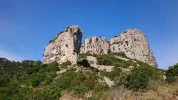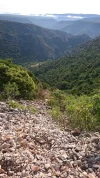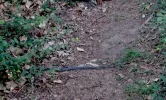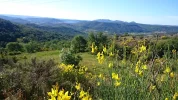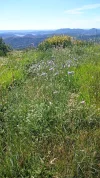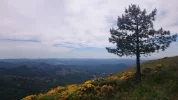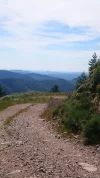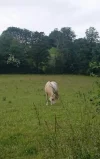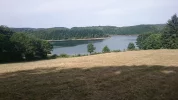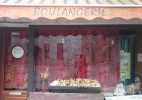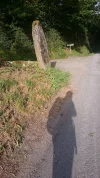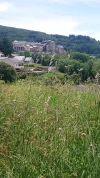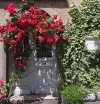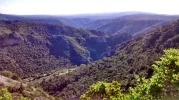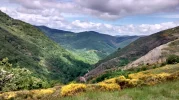Jan_D
Active Member
- Time of past OR future Camino
- 2021
So… I’ve just walked to Castres on the Chemin d’Arles. I had planned to go further, but temperatures were reaching over 40 degrees Celsius, and I was experiencing symptoms of heat exhaustion, so it would have been pretty stupid to continue.
I didn’t do too much advanced planning, in fact I didn’t even have a guidebook – I just used Gronze and Google maps. And to be honest, this was sufficient: Gronze is impressively up-to-date with accommodation info, and the GR 635 markings are excellent, so it’s very difficult to get lost. However, there were a few things that I had to learn the hard way... So this is basically a “things I wish I’d known” post, with a focus on the section through the Parc Naturel du Haut-Languedoc (that is, from St Guilhem-le-Desert, to just before Castres).
A lot of people have posted about the difficulty of this stretch, so my focus here is more on practical information, such as food, accommodation, and public transport. I’d like to say one thing about the difficulty: I don’t think I’d fully comprehended that this would be a walk through a nature reserve, and that there’d literally be no services for 20-30km stretches. In fact, on most days you’re pretty far from accessible roads. So you really do need to be prepared. Physically, I found it VERY challenging (I wasn’t exactly at my fittest to start with…ahem) but even more challenging was arriving at a small village after a very long day, only to find I’d just missed the window to collect the gîte keys, or that the épicerie I’d been counting on for a resupply was closed, or had shut down permanently. Miam Miam Dodo seemed to have the best practical information, but I think it’s difficult to keep track of what happens in some of these very isolated villages. Sometimes the boulangerie would simply have a sign on the door saying “closed until next week”, or you’d hear that the private gîte owner was away on holiday or had sold the property. There’s also a lack of public transport, so it’s simply not possible to jump ahead a stage or even just a few kilometres if ill, injured, or facing time constraints.
I’ll start with more general tips, before giving more specific practical info for the various stages. Obviously this is just based on my personal experiences, and based on an attempt to do things on a pilgrim-style budget, while leaving room for an element of serendipity, and not shying away from a bit of adversity... (So if you’re planning on booking all your hotels and meals ahead, and on using taxis, you’re probably going to find the following quite irrelevant!)
In general:
Accommodation: For those who don’t know, a Gîte Communal (GC) is basically a municipal albergue. They are run by the Mairie, and are usually quite cheap (€10-€18). But watch out! You have to collect the keys from the Mairie or Tourist Office - always right in the centre of town, so easy to find – but which, as you’ll soon discover, are usually closed for 2 or 3 hours over lunch, over the weekend, and sometimes on a certain days or afternoons of the week. If you miss the reception hours, don’t worry too much, there are always private options (this is where Gronze or a guidebook comes in handy – you will need telephone numbers and a French sim or roaming). I found that you don’t really need to call a day in advance – that is, not if you don’t expect dinner. I know that it’s usually considered polite to call ahead in France, but on the odd occasion I wasn’t able to stay in the GC, the private gîte owners seemed all too happy to get a bit of custom, even if it was a bit last minute. Then, of course, there are the chambres d’hôtes, i.e. hotel rooms, which you can reserve on booking.com. I also heard of an “association” that you can join that gives a list of farms/houses along the way prepared to host pilgrims. Sounds great, wish I’d known about it (although to be honest I quite like meeting up with other pilgrims at the end of the day if possible, so for me the GCs were fine). Also, I met a 70-year old Parisian man who had tried unsuccessfully to contact farms on the list on two occasions, but the occupants must have been away. He couldn’t go any further, so simply ended up sleeping outside. One of the big lessons I learned on this camino was checking my expectations for "comfort and choice on demand". From not being able to eat exactly what I wanted, to not having a coffee in the morning, or not having a choice with regards accommodation or transport... Also, some big lessons in patience. Time moves at a very different pace in this region. Sometimes there's nothing to do but find a spot of shade and wait it out.
Food: the private gîtes often – but not always – have demi-pension options (if you call a day in advance) but the GCs are self-catering. If you want to economise, then you’ll be dependent on the local épiceries and boulangeries for your daily fodder. Even if you do decide to organise a demi-pension option with a private gîte, you’ll need to buy food for lunch and snacks the next day. The opening hours of the tiny épiceries and boulangeries can be infuriating. I think Miam Miam Dodo provides opening hours for some of these establishments, and it is probably worth the €20 investment for this information alone (but as I said above, sometimes things change…) If you miss out on an anticipated resupply, don’t worry, you won’t starve: there’s usually a boulangerie, and if there's a bar, it will probably sells sandwiches or pizza. A Belgium pilgrim I met actually described his camino as “le Chemin du Pizza”, as it had been the only thing he’d eaten for about 5 days straight. It’s always a good idea to have some high energy snacks in your pack, just in case.
Water: You’ll generally have to carry all your water with you over the very long stages through the nature reserve. On some days won't pass a single village or farm. So be prepared!
Insects: You’ll be walking through a region famed for its biodiversity, and you’ll encounter a glorious range of flowers and insects. The problem with the latter is that many of them are of the biting or stinging variety. I didn’t pack bug spray, which is one of my only regrets. I experienced a very “biodiverse” range of bites all over my body! Maybe this is specific to the time of year I was walking (late June), and the fact that it was so hot, or the fact that my deodorant had a floral scent… who knows? In any case, I’d seriously recommend some sort of repellent. One pilgrim I met had been severely snacked on by mosquitoes in the camargue area. He stocked up on repellent in Montpellier and hadn’t suffered too much after that. Another insect you need to watch out for… TICKS!!! I had to flick off quite a few, and remove two that’d got stuck into my apparently scrumptious right shin. I didn’t have a special tick remover, and not much experience with ticks, so this stressed me out a fair bit. Be careful when walking through long grass or sitting on the ground. You sometimes won't have much choice, as the path can be overgrown, but just make sure your legs are covered up. As I said this is a “things I wish I’d known”, so hopefully if you read this you’ll be better prepared than me.
Allergies: Just a note to those who suffer from them: I actually met a pilgrim who had to take a detour to a town with a pharmacy to get antihistamines. As mentioned above, you’ll be walking through meadows of exquisite grasses and flora. I found that the walk in the ‘wild’ is usually ok, but as soon as you enter the villages or agricultural zones they seem to invest a great deal of time and energy in mowing these meadows flat. I don’t usually suffer from allergies very badly, but my exit and entry into the villages was usually accompanied by a great deal of sneezing. In some places you could actually see that the air was thick with airborne pollens and grasses. (Obviously the relevance of this information depends on the time of year you’ll be walking, and whether or not you are sensitive to this sort of thing).
Snakes: Now, I’m sure this is a relatively rare event, but I very nearly stepped on a snake while traipsing through an isolated stretch between Lodève and Lunas. Just mentioning it here in case. Sometimes the grass is very long and the path is very overgrown. Try and watch where you tread.
Hunting: There’s a lot of hunting in this region over the weekend. I came across quite a few groups, and heard quite a lot of gunfire, which can be quite unsettling. Just be vigilant, and if possible alert the hunters to your presence.
Wifi: None of the communal or private gîtes I stayed in had Wifi. So make sure you have enough data on your phone!!
Ok... so that's the more general part. More specific information on its way!!
I didn’t do too much advanced planning, in fact I didn’t even have a guidebook – I just used Gronze and Google maps. And to be honest, this was sufficient: Gronze is impressively up-to-date with accommodation info, and the GR 635 markings are excellent, so it’s very difficult to get lost. However, there were a few things that I had to learn the hard way... So this is basically a “things I wish I’d known” post, with a focus on the section through the Parc Naturel du Haut-Languedoc (that is, from St Guilhem-le-Desert, to just before Castres).
A lot of people have posted about the difficulty of this stretch, so my focus here is more on practical information, such as food, accommodation, and public transport. I’d like to say one thing about the difficulty: I don’t think I’d fully comprehended that this would be a walk through a nature reserve, and that there’d literally be no services for 20-30km stretches. In fact, on most days you’re pretty far from accessible roads. So you really do need to be prepared. Physically, I found it VERY challenging (I wasn’t exactly at my fittest to start with…ahem) but even more challenging was arriving at a small village after a very long day, only to find I’d just missed the window to collect the gîte keys, or that the épicerie I’d been counting on for a resupply was closed, or had shut down permanently. Miam Miam Dodo seemed to have the best practical information, but I think it’s difficult to keep track of what happens in some of these very isolated villages. Sometimes the boulangerie would simply have a sign on the door saying “closed until next week”, or you’d hear that the private gîte owner was away on holiday or had sold the property. There’s also a lack of public transport, so it’s simply not possible to jump ahead a stage or even just a few kilometres if ill, injured, or facing time constraints.
I’ll start with more general tips, before giving more specific practical info for the various stages. Obviously this is just based on my personal experiences, and based on an attempt to do things on a pilgrim-style budget, while leaving room for an element of serendipity, and not shying away from a bit of adversity... (So if you’re planning on booking all your hotels and meals ahead, and on using taxis, you’re probably going to find the following quite irrelevant!)
In general:
Accommodation: For those who don’t know, a Gîte Communal (GC) is basically a municipal albergue. They are run by the Mairie, and are usually quite cheap (€10-€18). But watch out! You have to collect the keys from the Mairie or Tourist Office - always right in the centre of town, so easy to find – but which, as you’ll soon discover, are usually closed for 2 or 3 hours over lunch, over the weekend, and sometimes on a certain days or afternoons of the week. If you miss the reception hours, don’t worry too much, there are always private options (this is where Gronze or a guidebook comes in handy – you will need telephone numbers and a French sim or roaming). I found that you don’t really need to call a day in advance – that is, not if you don’t expect dinner. I know that it’s usually considered polite to call ahead in France, but on the odd occasion I wasn’t able to stay in the GC, the private gîte owners seemed all too happy to get a bit of custom, even if it was a bit last minute. Then, of course, there are the chambres d’hôtes, i.e. hotel rooms, which you can reserve on booking.com. I also heard of an “association” that you can join that gives a list of farms/houses along the way prepared to host pilgrims. Sounds great, wish I’d known about it (although to be honest I quite like meeting up with other pilgrims at the end of the day if possible, so for me the GCs were fine). Also, I met a 70-year old Parisian man who had tried unsuccessfully to contact farms on the list on two occasions, but the occupants must have been away. He couldn’t go any further, so simply ended up sleeping outside. One of the big lessons I learned on this camino was checking my expectations for "comfort and choice on demand". From not being able to eat exactly what I wanted, to not having a coffee in the morning, or not having a choice with regards accommodation or transport... Also, some big lessons in patience. Time moves at a very different pace in this region. Sometimes there's nothing to do but find a spot of shade and wait it out.
Food: the private gîtes often – but not always – have demi-pension options (if you call a day in advance) but the GCs are self-catering. If you want to economise, then you’ll be dependent on the local épiceries and boulangeries for your daily fodder. Even if you do decide to organise a demi-pension option with a private gîte, you’ll need to buy food for lunch and snacks the next day. The opening hours of the tiny épiceries and boulangeries can be infuriating. I think Miam Miam Dodo provides opening hours for some of these establishments, and it is probably worth the €20 investment for this information alone (but as I said above, sometimes things change…) If you miss out on an anticipated resupply, don’t worry, you won’t starve: there’s usually a boulangerie, and if there's a bar, it will probably sells sandwiches or pizza. A Belgium pilgrim I met actually described his camino as “le Chemin du Pizza”, as it had been the only thing he’d eaten for about 5 days straight. It’s always a good idea to have some high energy snacks in your pack, just in case.
Water: You’ll generally have to carry all your water with you over the very long stages through the nature reserve. On some days won't pass a single village or farm. So be prepared!
Insects: You’ll be walking through a region famed for its biodiversity, and you’ll encounter a glorious range of flowers and insects. The problem with the latter is that many of them are of the biting or stinging variety. I didn’t pack bug spray, which is one of my only regrets. I experienced a very “biodiverse” range of bites all over my body! Maybe this is specific to the time of year I was walking (late June), and the fact that it was so hot, or the fact that my deodorant had a floral scent… who knows? In any case, I’d seriously recommend some sort of repellent. One pilgrim I met had been severely snacked on by mosquitoes in the camargue area. He stocked up on repellent in Montpellier and hadn’t suffered too much after that. Another insect you need to watch out for… TICKS!!! I had to flick off quite a few, and remove two that’d got stuck into my apparently scrumptious right shin. I didn’t have a special tick remover, and not much experience with ticks, so this stressed me out a fair bit. Be careful when walking through long grass or sitting on the ground. You sometimes won't have much choice, as the path can be overgrown, but just make sure your legs are covered up. As I said this is a “things I wish I’d known”, so hopefully if you read this you’ll be better prepared than me.
Allergies: Just a note to those who suffer from them: I actually met a pilgrim who had to take a detour to a town with a pharmacy to get antihistamines. As mentioned above, you’ll be walking through meadows of exquisite grasses and flora. I found that the walk in the ‘wild’ is usually ok, but as soon as you enter the villages or agricultural zones they seem to invest a great deal of time and energy in mowing these meadows flat. I don’t usually suffer from allergies very badly, but my exit and entry into the villages was usually accompanied by a great deal of sneezing. In some places you could actually see that the air was thick with airborne pollens and grasses. (Obviously the relevance of this information depends on the time of year you’ll be walking, and whether or not you are sensitive to this sort of thing).
Snakes: Now, I’m sure this is a relatively rare event, but I very nearly stepped on a snake while traipsing through an isolated stretch between Lodève and Lunas. Just mentioning it here in case. Sometimes the grass is very long and the path is very overgrown. Try and watch where you tread.
Hunting: There’s a lot of hunting in this region over the weekend. I came across quite a few groups, and heard quite a lot of gunfire, which can be quite unsettling. Just be vigilant, and if possible alert the hunters to your presence.
Wifi: None of the communal or private gîtes I stayed in had Wifi. So make sure you have enough data on your phone!!
Ok... so that's the more general part. More specific information on its way!!
Last edited:




